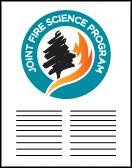United States Joint Fire Science Program
Document Type
Article
Date of this Version
2007
Citation
Final Report: JFSP – 04-2-1-85
Abstract
Soil properties were examined at a season of burn and burn interval study located in the Malheur National for responses to prescribed burns used to reduce fuel loads and wildfire hazard. Prescribed burn comparisons included spring vs. fall burning, with either one 15-year interval burn or two 5-year interval burns of each season. Results showed that major change to soil organic matter was a reduction in the amount of O horizon. The percent bare ground increased with both spring and fall burning and was highest with multiple burns, indicating a loss of O horizon cover. There was also a decrease in O horizon thickness, particularly with two fall burns. Overall ecosystem C decreased by 21-31 percent with the prescribed burns. Extractable ammonium and phosphorus increased with the multiple burns relative to the single burn, but was similar to the controls. The flush of nutrients available following the burns may not persist more than 5 years. No burn effects were seen on soil cation exchange capacity or percent base saturation, possibly due to the high CEC and base cations in these soils. Soil temperatures were found to be highest with fall burns, particularly the 5-year interval burns. However, the soil moisture was also slightly higher with the 5-year interval burns, possibly due to decrease transpiration from reduced vegetation. Results to date suggest that the frequent fall burns may be harsher for soils than less frequent burns or spring burns, but could be used if needed, however they will reduce ecosystem C pools.
Included in
Forest Biology Commons, Forest Management Commons, Natural Resources and Conservation Commons, Natural Resources Management and Policy Commons, Other Environmental Sciences Commons, Other Forestry and Forest Sciences Commons, Sustainability Commons, Wood Science and Pulp, Paper Technology Commons



Comments
US government work.